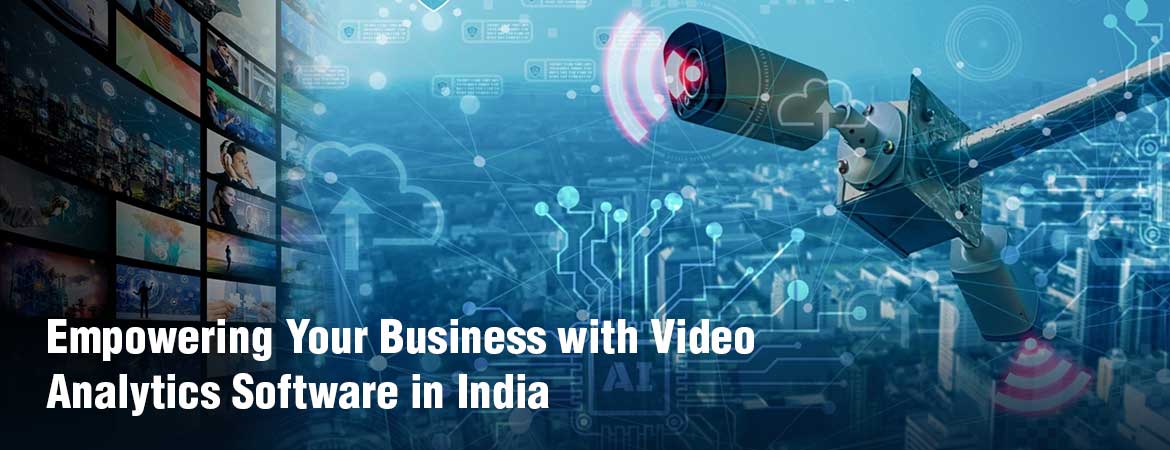
We use cookies to ensure that we give you the best experience on our website.
By using this site, you agree to our use of cookies. Find out more.
In conclusion, AI and video analytics have significantly enhanced what was possible with traditional CCTV systems. By tapping into detection capabilities, distributed intelligence, and scalability offered through edge computing, businesses can now extract optimal value from their video investments.

With technological advancements, video surveillance is evolving beyond basic recording to intelligent solutions driven by video analytics and artificial intelligence. These smart video tools are empowering businesses across India to derive powerful insights from footage and enhance various operations. This blog discusses how AI-based video analysis software provides valuable intelligence and security benefits. It covers key aspects like components, detection capabilities, edge computing advantages and how the technology works. Leveraging computer vision and deep learning, organizations can automate monitoring, improve processes, and make informed decisions. Whether ensuring safety or gaining business insights, video analytics is a compelling technology for growth and efficiency.
Video analytics software utilizes artificial intelligence and computer vision algorithms to automatically analyze videos from surveillance cameras in real-time. It detects, recognizes and tracks objects or events of interest from the video feed. These could include people, vehicles, suspicious behaviors, left behind packages etc.
The software intelligently filters through video data to recognize patterns and anomalies. It then automates notification of security personnel through alerts on smartphones and dashboards regarding the detection of predefined incidents. This helps monitoring of large and distributed camera networks with ease by reducing dependence on human surveillance alone. The analytics are embedded directly into the video management system or offered as a standalone product that works with existing video solutions. Its insights enable businesses to improve operations, safety and gain valuable business intelligence.
Here are the Key Components Of AI-Based Video Surveillance Systems:
Artificial Intelligence is the middle era that powers superior video analytics skills. AI refers back to the capability of machines to simulate human intelligence via deep learning and perform cognitive functions like sensory records belief, reasoning, hassle-fixing, understanding acquisition and moving understanding among domain names.
In video analytics structures, AI algorithms are educated on huge datasets of labelled movies to apprehend and recognize visual scenes. The algorithms use statistical strategies to uncover complicated styles in video and relate new records with earlier learnings. This enables the machine to mechanically analyze stay video streams from cameras, locate gadgets and behaviors, learn evolving styles over the years without being explicitly programmed for every project. AI consequently fuels the intelligence behind smart video surveillance answers.
Machine mastering and deep getting to know are key techniques used in AI-based video analytics. Machine studying is based on algorithms which can routinely adapt to new inputs and research from information available with no need to be reprogrammed. It detects patterns in video records that may be used to make knowledgeable predictions and detections. Deep learning is a department of machine learning that uses deep neural networks, which might be loosely stimulated by the human brain.
These networks are capable of studying complex styles and relationships inside massive datasets. Deep learning lets in AI structures to obtain higher accuracy in video analysis responsibilities like facial recognition, item detection and tracking through coming across elaborate functions via many interconnected processing layers, as opposed to standard processing. It permits extra self sustaining and complex video expertise.
AI-based video analytics leverage deep learning and device getting to know strategies to robotically examine stay video feeds from IP cameras. The cameras flow excessive-definition video statistics to part servers or gadgets locally installed on-premises which have effective processors and garage. These edge structures run state-of-the-art AI fashions which have been skilled on good sized libraries of categorized videos to understand items, behaviors, occasions and anomalies. In real-time, the edge devices process the stay video feeds from multiple cameras the use of these models. As the video is analyzed body-by way of-frame, the AI can detect predefined incidents and conditions.
Whenever it spots something sizeable, the edge machine generates an alert notification together with applicable metadata. This fact is then driven instantly to monitoring systems and personnel via mobile/computing device apps and dashboards, permitting instant reaction. Simultaneously, the metadata and alarms also are transmitted to centralized video management software program and cloud systems for superior analytics, reporting and long-time period storage. This closed-loop workflow ensures AI-primarily based video surveillance offers proactive insights with minimum latency.

Here are some key things that AI video analytics can detect:
Here are the key reasons to compute AI-based video analytics at the edge rather than in the cloud:
Computing AI-based video analytics at the edge directly on on-premise servers and devices ensures significantly reduced latency compared to cloud-only solutions. With edge deployment, the live video feeds from cameras do not need to be continuously streamed over the network to an external cloud platform for analysis. Instead, the computation happens locally where the video source and edge infrastructure are collocated. This eliminates network transmission delays involved in uploading voluminous video to the cloud and then downloading back alerts. As a result, real-time detections, alarms and automated responses can happen instantly for immediate security or business actions.
Processing surveillance video and the associated data on private edge devices located on-premises enhances privacy and security considerably. When AI analysis is computed locally, sensitive streaming video content and metadata never have to traverse public internet to reach an external cloud platform. This prevents any potential leaks or unauthorized access to confidential visual data during transmission. Edge deployment also ensures organizations maintain complete control and ownership of their surveillance resources and video intelligence within secure local networks. The risk of data breach is thus minimized greatly.
Computing video analytics closer to cameras at the network edge provides major bandwidth efficiencies over cloud-only solutions. Edge deployment allows only relevant alerts, metadata and insights extracted by AI models to be sent to centralized control rooms or clouds rather than large full-motion video streams. This transfers significantly lighter data volumes. As a result, less internet bandwidth is consumed for video surveillance which saves on network transmission costs. The edge approach also ensures resilient analytics even during temporary bandwidth constraints as it reduces dependency on continuous cloud connectivity.
Carrying out AI video analysis locally at the network edge through on-site servers and devices allows the system to continue operating autonomously even during interruptions to internet connectivity. Should there be temporary network outages disrupting cloud communications, the edge infrastructure can perform real-time video surveillance independently without cloud reliance. It can process live feeds, run analytical models, recognize patterns, generate alerts and store relevant metadata locally. Once network access resumes, it can sync gathered insights with centralized systems. This ensures uninterrupted safety and security even in offline scenarios.
The extremely low latency of edge computing makes it ideally suited for applications needing urgent real-time decision making like security and public safety. When AI video processing is deployed at the network boundary close to cameras, it can generate alerts and notifications almost instantly as issues are detected in the live video stream. This enables immediate automated responses or manual interventions by security personnel. Latency-sensitive tasks such as crowd control, fire detection, intruder alarms benefit greatly from edge intelligence that empowers real-time situational awareness and prompt security actions without cloud delays.
A hybrid edge-cloud model for AI video analytics provides significantly enhanced scalability over solely relying on cloud infrastructure. As the distributed edge servers absorb a bulk of video analysis workloads locally at each site, it reduces overhead for centralized cloud platforms. More cameras can be added across multiple locations without overburdening core networks. The cloud additionally offers elastic capacity for expanding data volumes or advanced tasks. Together this distributed architecture ensures the solution can smoothly adapt processing capabilities according to fluctuating loads. Scalability is thus optimized to support unlimited growth of surveillance deployments.
In conclusion, AI and video analytics have significantly enhanced what was possible with traditional CCTV systems. By tapping into detection capabilities, distributed intelligence, and scalability offered through edge computing, businesses can now extract optimal value from their video investments. With issues addressed in real-time and data-driven decisions, these solutions empower varied functions across industries. While privacy and responsible usage are important factors, video analytics undoubtedly provides powerful solutions for security, operations, and strategic planning. Leveraging this innovation is sure to give companies competitive advantages through improved situational awareness and business intelligence.
Leave a Comment
Your email address will not be published.